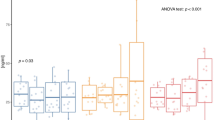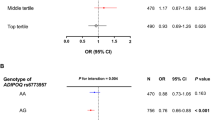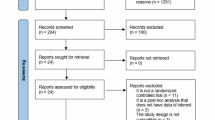Abstract
Background:
Early adiposity rebound (AR <5 years) has been consistently associated with increased obesity risk, but its relationship with metabolic markers is less clear; in addition, the biologic mechanisms involved in these associations have not been established.
Objective:
The objective of this study was to assess the association between timing of AR and metabolic status at age 7 years, evaluating the potential role of adiposity, adipose functionality and skeletal maturation in this association.
Design:
We estimated the age of AR from the body mass index (BMI) trajectories from 0 to 7 years in 910 children from the Growth and Obesity Chilean Cohort Study (GOCS). At 7 years, we measured waist circumference (WC) and blood glucose, insulin, triglycerides and high-density lipoprotein-cholesterol levels and constructed a metabolic risk score. We also measured percent fat mass (adiposity), plasma concentrations of leptin and adiponectin (adipose functionality) and bone age using wrist ultrasound (skeletal maturation).
Results:
We found that 44% of the children had an AR <5 years. Earlier AR was associated with larger WC (β: 5.10 (95% confidence interval (CI): 4.29–5.91)), higher glucose (β: 1.02 (1.00–1.03)), insulin resistance (β Homeostatic Model Assessment: 1.06 (1.03–1.09)), triglycerides (β: 10.37 (4.01–6.73)) and adverse metabolic score (β: 0.30 (0.02–0.37)). Associations decreased significantly if adiposity was added to the models (i.e. β WC: 0.85 (0.33–1.38)) and, to a lesser extent, when adipokines (i.e. β WC: 0.73 (0.14–1.32)) and skeletal maturation (i.e. β WC: 0.65 (0.10–1.20)) were added.
Conclusion:
In GOCS children, AR at a younger age predicts higher metabolic risk at 7 years; these associations are mostly explained by increased adiposity, but adipose dysfunction and accelerated skeletal maturation also have a role.
This is a preview of subscription content, access via your institution
Access options
Subscribe to this journal
Receive 12 print issues and online access
$259.00 per year
only $21.58 per issue
Buy this article
- Purchase on SpringerLink
- Instant access to full article PDF
Prices may be subject to local taxes which are calculated during checkout
Similar content being viewed by others
References
Sundstrom J, Riserus U, Byberg L, Zethelius B, Lithell H, Lind L . Clinical value of the metabolic syndrome for long term prediction of total and cardiovascular mortality: prospective, population based cohort study. BMJ 2006; 332: 878–882.
Mendis S, Puska P, Norrving B . Global Atlas on Cardiovascular Disease Prevention and Control. World Health Organization: Geneva, Switzerland, 2011.
Li S, Chen W, Srinivasan SR, Bond MG, Tang R, Urbina EM et al. Childhood cardiovascular risk factors and carotid vascular changes in adulthood: the Bogalusa Heart Study. JAMA 2003; 290: 2271–2276.
Morrison JA, Friedman LA, Wang P, Glueck CJ . Metabolic syndrome in childhood predicts adult metabolic syndrome and type 2 diabetes mellitus 25 to 30 years later. J Pediatr 2008; 152: 201–206.
Sun SS, Liang R, Huang TT, Daniels SR, Arslanian S, Liu K et al. Childhood obesity predicts adult metabolic syndrome: the Fels Longitudinal Study. J Pediatr 2008; 152: 191–200.
van Vliet M, Heymans MW, von Rosenstiel IA, Brandjes DP, Beijnen JH, Diamant M . Cardiometabolic risk variables in overweight and obese children: a worldwide comparison. Cardiovasc Diabetol 2011; 10: 106.
Finer N . Early Cardiometabolic risk factors in children and young people. Off J Int Chair Cardiometabolic Risk 2010; 3: 5–8.
Weiss R, Dziura J, Burgert TS, Tamborlane WV, Taksali SE, Yeckel CW et al. Obesity and the metabolic syndrome in children and adolescents. N Engl J Med 2004; 350: 2362–2374.
Isomaa B, Almgren P, Tuomi T, Forsen B, Lahti K, Nissen M et al. Cardiovascular morbidity and mortality associated with the metabolic syndrome. Diabetes Care 2001; 24: 683–689.
Malik S, Wong ND, Franklin SS, Kamath TV, L'Italien GJ, Pio JR et al. Impact of the metabolic syndrome on mortality from coronary heart disease, cardiovascular disease, and all causes in United States adults. Circulation 2004; 110: 1245–1250.
Gami AS, Witt BJ, Howard DE, Erwin PJ, Gami LA, Somers VK et al. Metabolic syndrome and risk of incident cardiovascular events and death: a systematic review and meta-analysis of longitudinal studies. J Am Coll Cardiol 2007; 49: 403–414.
Dietz WH . Critical periods in childhood for the development of obesity. Am J Clin Nutr 1994; 59: 955–959.
Dietz WH . Periods of risk in childhood for the development of adult obesity—what do we need to learn? J Nutr 1997; 127: 1884S–1886S.
Cameron N, Demerath E . Critical periods in human growth and their relationship to diseases of aging. Phys Anthropol 2002; 45: 159–184.
Rolland-Cachera MF, Deheeger M, Bellisle F, Sempe M, Guilloud-Bataille M, Patois E . Adiposity rebound in children: a simple indicator for predicting obesity. Am J Clin Nutr 1984; 39: 129–135.
Whitaker RC, Pepe MS, Wright JA, Seidel KD, Dietz WH . Early adiposity rebound and the risk of adult obesity. Pediatrics 1998; 101: E5.
Taylor RW, Grant AM, Goulding A, Williams SM . Early adiposity rebound: review of papers linking this to subsequent obesity in children and adults. Curr Opin Clin Nutr Metab Care 2005; 8: 607–612.
Williams SM, Goulding A . Early adiposity rebound is an important predictor of later obesity. Obesity (Silver Spring, MD) 2009; 17: 1310.
Eriksson JG, Forsen T, Tuomilehto J, Osmond C, Barker DJ . Early adiposity rebound in childhood and risk of Type 2 diabetes in adult life. Diabetologia 2003; 46: 190–194.
Wadsworth M, Butterworth S, Marmot M, Ecob R, Hardy R . Early growth and type 2 diabetes: evidence from the 1946 British birth cohort. Diabetologia 2005; 48: 2505–2510.
Bhargava SK, Sachdev HS, Fall CH, Osmond C, Lakshmy R, Barker DJ et al. Relation of serial changes in childhood body-mass index to impaired glucose tolerance in young adulthood. N Engl J Med 2004; 350: 865–875.
Harman-Boehm I, Bluher M, Redel H, Sion-Vardy N, Ovadia S, Avinoach E et al. Macrophage infiltration into omental versus subcutaneous fat across different populations: effect of regional adiposity and the comorbidities of obesity. J Clin Endocrinol Metab 2007; 92: 2240–2247.
Utriainen P, Jaaskelainen J, Romppanen J, Voutilainen R . Childhood metabolic syndrome and its components in premature adrenarche. J Clin Endocrinol Metab 2007; 92: 4282–4285.
Williams S, Davie G, Lam F . Predicting BMI in young adults from childhood data using two approaches to modelling adiposity rebound. Int J Obes Relat Metab Disord 1999; 23: 348–354.
Williams S, Dickson N . Early growth, menarche, and adiposity rebound. Lancet 2002; 359: 580–581.
Corvalan C, Uauy R, Kain J, Martorell R . Obesity indicators and cardiometabolic status in 4-y-old children. Am J Clin Nutr 2010; 91: 166–174.
Corvalan C, Uauy R, Stein AD, Kain J, Martorell R . Effect of growth on cardiometabolic status at 4 y of age. Am J Clin Nutr 2009; 90: 547–555.
Seigler L, Wu WT . Separation of serum high-density lipoprotein for cholesterol determination: ultracentrifugation vs precipitation with sodium phosphotungstate and magnesium chloride. Clin Chem 1981; 27: 838–841.
Friedewald WT, Levy RI, Fredrickson DS . Estimation of the concentration of low-density lipoprotein cholesterol in plasma, without use of the preparative ultracentrifuge. Clin Chem 1972; 18: 499–502.
Myers GL, Kimberly MM, Waymack PP, Smith SJ, Cooper GR, Sampson EJ . A reference method laboratory network for cholesterol: a model for standardization and improvement of clinical laboratory measurements. Clin Chem 2000; 46: 1762–1772.
Centers for Disease Control and Prevention (CDC). Clinical laboratory measurements traceable to the National Reference System for Cholesterol. Morb Mortal Wkly Rep 1994; 43: 149–151.
Matthews DR, Hosker JP, Rudenski AS, Naylor BA, Treacher DF, Turner RC . Homeostasis model assessment: insulin resistance and beta-cell function from fasting plasma glucose and insulin concentrations in man. Diabetologia 1985; 28: 412–419.
Fernandez JR, Redden DT, Pietrobelli A, Allison DB . Waist circumference percentiles in nationally representative samples of African-American, European-American, and Mexican-American children and adolescents. J Pediatr 2004; 145: 439–444.
Association AD . Diagnosis and classification of diabetes mellitus. Diabetes Care 2006; 29 (Suppl 1) S43–S48.
Keskin M, Kurtoglu S, Kendirci M, Atabek ME, Yazici C . Homeostasis model assessment is more reliable than the fasting glucose/insulin ratio and quantitative insulin sensitivity check index for assessing insulin resistance among obese children and adolescents. Pediatrics 2005; 115: e500–e503.
Daniels SR, Greer FR . Lipid screening and cardiovascular health in childhood. Pediatrics 2008; 122: 198–208.
Zimmet P, Alberti KG, Kaufman F, Tajima N, Silink M, Arslanian S et al. The metabolic syndrome in children and adolescents—an IDF consensus report. Pediatr Diabetes 2007; 8: 299–306.
Slaughter MH, Lohman TG, Boileau RA, Horswill CA, Stillman RJ, Van Loan MD et al. Skinfold equations for estimation of body fatness in children and youth. Hum Biol 1988; 60: 709–723.
Skinner JD, Bounds W, Carruth BR, Morris M, Ziegler P . Predictors of children's body mass index: a longitudinal study of diet and growth in children aged 2-8 y. Int J Obes Relat Metab Disord 2004; 28: 476–482.
Boonpleng W, Park CG, Gallo AM . Timing of adiposity rebound: a step toward preventing obesity. Pediatr Nurs 2012; 38: 37–42.
Vignerova J, Humenikova L, Brabec M, Riedlova J, Blaha P . Long-term changes in body weight, BMI, and adiposity rebound among children and adolescents in the Czech Republic. Econ Hum Biol 2007; 5: 409–425.
Dorosty AR, Emmett PM, Cowin S, Reilly JJ . Factors associated with early adiposity rebound. ALSPAC Study Team. Pediatrics 2000; 105: 1115–1118.
Lobstein T, Baur L, Uauy R . Obesity in children and young people: a crisis in public health. Obes Rev 2004; 5 ( (Suppl 1) 4–104.
Gunther AL, Buyken AE, Kroke A . The influence of habitual protein intake in early childhood on BMI and age at adiposity rebound: results from the DONALD Study. Int J Obes (Lond) 2006; 30: 1072–1079.
Campbell MW, Williams J, Carlin JB, Wake M . Is the adiposity rebound a rebound in adiposity? Int J Pediatr Obes 2011; 6: e207–e215.
Weiss R, Kaufman FR . Metabolic complications of childhood obesity: identifying and mitigating the risk. Diabetes Care 2008; 31 ( (Suppl 2) S310–S316.
Sun S WR, Czerwinski S . BMI at adiposity rebound, puberty, and postpuberty in relation to adulthood cardiovascular risk factors [abstract]. Circulation 2005; 111: E79.
Taylor RW, Goulding A, Lewis-Barned NJ, Williams SM . Rate of fat gain is faster in girls undergoing early adiposity rebound. Obes Res 2004; 12: 1228–1230.
Williams SM, Goulding A . Patterns of growth associated with the timing of adiposity rebound. Obesity (Silver Spring, MD) 2009; 17: 335–341.
Mentzel HJ, Vilser C, Eulenstein M, Schwartz T, Vogt S, Bottcher J et al. Assessment of skeletal age at the wrist in children with a new ultrasound device. Pediatr Radiol 2005; 35: 429–433.
Acknowledgements
We thank all the study personnel, particularly to Daniela Gonzalez, for field work coordination; we are also indebted to all the GOCS participants who continue supporting our work. This work was supported by FONDECYT (grant no. 1090252). LG has an International Cooperation Agency of Chile Fellowship, and CC has a Wellcome Trust Training Fellowship.
Author Contributions
The authors' responsibilities were as follows: LG, CC, RU: designed the study; CC: planned analyses, LG: conducted the analyses and wrote the original draft of the article; and CC, JK, AP, MG and RU: helped edit the drafts.
Author information
Authors and Affiliations
Corresponding author
Ethics declarations
Competing interests
The authors declare no conflict of interest.
Rights and permissions
About this article
Cite this article
González, L., Corvalán, C., Pereira, A. et al. Early adiposity rebound is associated with metabolic risk in 7-year-old children. Int J Obes 38, 1299–1304 (2014). https://doi.org/10.1038/ijo.2014.97
Received:
Revised:
Accepted:
Published:
Issue date:
DOI: https://doi.org/10.1038/ijo.2014.97
This article is cited by
-
Longitudinal association between the timing of adiposity peak and rebound and overweight at seven years of age
BMC Pediatrics (2022)
-
Sexual dimorphism of leptin and adiposity in children between 0 and 10 years: a systematic review and meta-analysis
Biology of Sex Differences (2022)
-
Why do humans undergo an adiposity rebound? Exploring links with the energetic costs of brain development in childhood using MRI-based 4D measures of total cerebral blood flow
International Journal of Obesity (2022)
-
Age at adiposity rebound and the relevance for obesity: a systematic review and meta-analysis
International Journal of Obesity (2022)
-
Infant feeding practices associated with adiposity peak and rebound in the EDEN mother–child cohort
International Journal of Obesity (2022)



